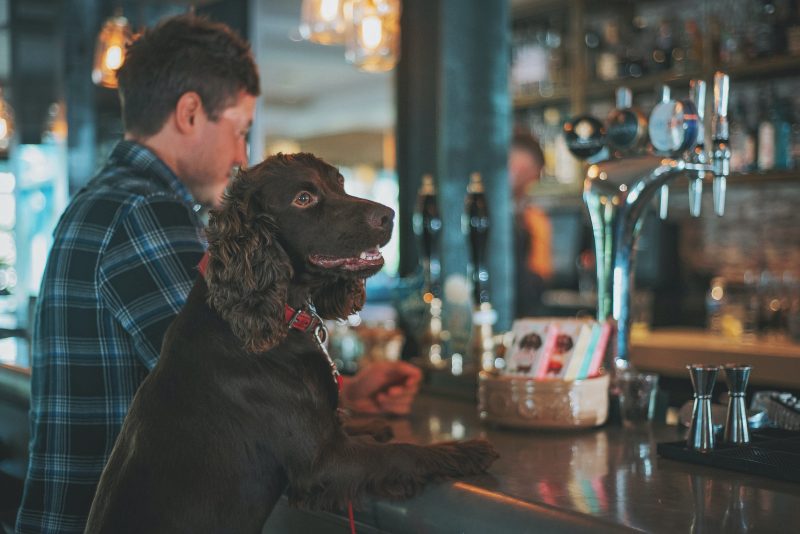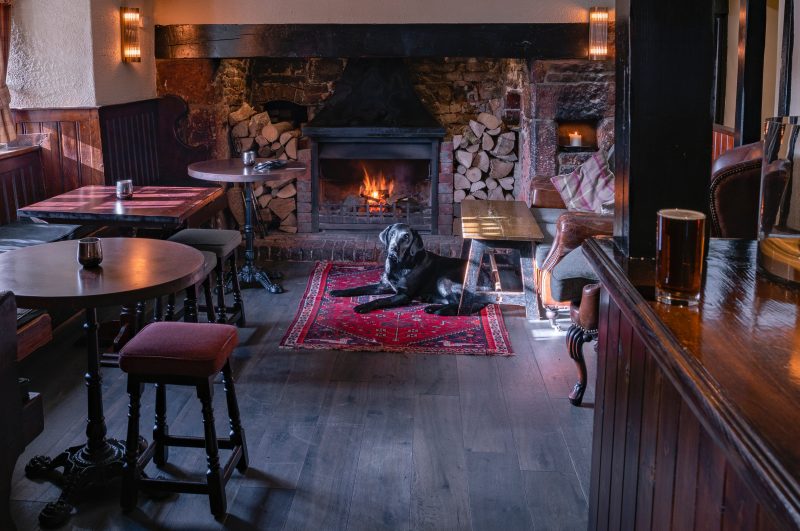Pub Dogs and Travel Tuffies
Owning a dog can be a lot of work; two walks a day, feeding, training and just planning around them can be difficult and time-consuming. It’s a good idea to find ways of incorporating them into your daily life as much as possible. If you’re someone that likes to go out to restaurants or pubs, why not take them with you. Below I’ll make the case for doing so and offer some advice on how to get started especially with nervous dogs.
Why bring your dog to the pub?
Why wouldn’t you! The smells, noises, and general business of the pub will tire your dog out, as will the walk there and back, so you can give yourself a bit more time on a Friday night and skip their usual PM walk. Exposure to busy environments exhausts our dog, Gerry, just as much, if not more than his usual route.

Brown Spaniel Waiting to Be Served at the Bar
Secondly, most dogs just prefer it to being at home. Even if it’s noisy and they have to lie on a hard floor under the table (although you should bring your Travel Tuffie with you if you have one) they would still rather be with you than be left behind at home. Dogs are pack animals and you are the pack.
The main reason for taking your dog with you to the pub is that it’s usually full of exactly the type of stimuli you’ll want to desensitise them to. Squeaky bar stools, music, doors closing, laughter and shouting are all things you’ll want your dog to get used to. Obviously this is not the type of environment you want to throw a nervous dog into, but it’s a great place for adolescent dogs who have mastered the basics to level up. Those formative first few years are the best time to introduce noisier environments but it’s never too late to work on. Start at a quieter bar or restaurant during the day when it’s less busy and build it up over time.

Black Labrador Waiting Beside Fireplace
Gerry has always had a bit of a disliking towards flat faced dogs – no idea why, he’s never had a bad experience with one. As a result, we’re always on the lookout for Pugs, Bulldogs, and French Bulldogs so we can shower him with treats around them. There aren’t many in the area that we live but we’ve found that we’re more likely to bump into them in city centres and pubs. Another common trigger for dogs can be large men, especially the loud and noisy kind. Where better to find them than a pub where people must raise their voices to be heard. Gerry used to also get a bit spooked around kids so we made an effort to walk him by a local school at 8.50am whilst they were all gathering outside. By the way the aim here is just to reward for being in proximity, not to force them towards something they’re scared of. When we started desensitising Gerry to kids we’d ask them not to approach and walked on the other side of the road, just close enough for him to see, hear and smell them without having to interact.
My Dog’s Nervous – Where do I begin?
Just like every other aspect of training, you’ll need to start small and build it up. Any rushing will result in an even more nervous dog. Start by walking to the pub and back again without going in, reward heavily as you approach and continue to do so as you walk by the entrance. This is all about changing your dog’s mindset from ‘uh oh’ to ‘yas, good things happen here’. You’ll know how fast to progress by their body language, if they’re still looking around them and not at you, or their ears are back, tail is between their legs, or their head is low then maintain or go back a step. If they aren’t bothered and stare at you for that chicken then you can go up a step and poke your head in the door. It usually doesn’t take long but it is much better to er on the side of caution, especially if your dog is a bit nervous in other areas of his/her life.

Worried Chihuahua
While we’re on the subject of nervousness. Pay attention to the level of excitement your dog exhibits at home day to day and whether you unintentionally contribute to it. An excited dog is often, but not always, an anxious dog too. Obviously you can still play with them but try and minimise high pitch tones of voice and excitable belly rubs if they’re exhibiting nervous behaviours, even if those behaviours are in totally different settings.
Are Dogs Allowed?
You should 100% just ask the pub if you’re not sure. Just because they don’t mention it either way on their website doesn’t mean ‘no dogs allowed’. Most pubs have no problem with it because it wins them a customer at the end of the day, especially since the ‘puppy boom’ of Covid when a lot of pubs were forced to accommodate dogs. Just make sure they don’t cock their leg on the bar stools!
Speaking of Travel Tuffies…
The Travel Tuffie was designed for people who regularly take their dogs with them, because they’re light, easy to carry and fold well into awkward spaces. We often take ours to the pub, or even just the cover which is even lighter but still thick enough to keep Gerry comfy on the floor. We figure that if he’s going to have drunk people coming up to him left right and centre, slurring their words about how cute he is, then he at least deserves to be on the best travel dog bed going. The other thing about the travel tuffie is that the cover can just go in the wash and the inner bed is protected by a waterproof material, so if the floor is a bit wet and sticky you won’t have to chuck the whole bed out when it starts smelling in a few months time.
Good luck and send us your pub dog pics!
-
26/04/2022 10:44
Why You Should Choose Camping with your Dog this Summer - Tuffies Waterproof Dog Beds
Summer is only around the corner and you’ve probably started to think a little bit about where to spend your Summer holiday. Here’s why you should consider camping trips, why your dog will appreciate it, and some tip.. -
15/09/2022 13:27
How to Fix a Reactive Dog - Nest Dog Bed
Your dog is the kindest, calmest, well-mannered pooch of all time at home but as soon as they see another dog, Satan emerges. They'll fight to get close, bark, growl and even attack if left to their own devices. Sound fa..




